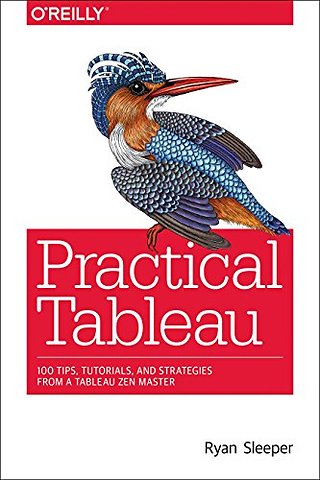


As Director of Data Visualization & Analysis at Evolytics, my specialty is helping businesses understand their data through visualization – primarily using Tableau.
Meer over Ryan SleeperPractical Tableau
100 Tips, Tutorials, and Strategies from A Tableau Zen Masters
Paperback Engels 2018 1e druk 9781491977316Samenvatting
If you’re just getting started with Tableau software—or already know some of the fundamentals—this practical book will take you to the next level for building compelling, interactive data visualization applications. Author Ryan Sleeper is one of the most qualified Tableau consultants in the world, having earned the titles of Tableau Zen Master (2016/17), Tableau Iron Viz Champion (2013), and author of the Tableau Public Visualization of the Year (2015). 'Practical Tableau' takes you beyond web posts and videos to give you a firm understanding in Tableau for finding valuable insights in data.
You’ll start with the fundamentals—either to learn them for the first time or to brush up on key concepts—and then dive into a strategic framework for data visualization and storytelling techniques. You’ll also learn valuable tips and tricks created by the author.
Practical Tableau is organized into five sections:
- Fundamentals: get started using Tableau from scratch
- Framework: explore the INSIGHT framework, a proprietary process for building Tableau dashboards
- Storytelling: learn tangible tactics for storytelling with data
- Chart Types: use step-by-step tutorials to build a variety of charts in Tableau
- Tips & Tricks: learn innovative uses of parameters, color theory, making your Tableau workbooks run efficiently, and more
Specificaties
Lezersrecensies
Inhoudsopgave
Chapter 2. Which Tableau Product is Best for Me
Chapter 3. An Introduction to Connecting to Data
Chapter 4. Shaping Data for Use with Tableau
Chapter 5. Getting a Lay of the Land
Chapter 6. Dimension vs Measure
Chapter 7. Discrete vs Continuous
Chapter 8. 5 Ways to Make a Bar Chart
Chapter 9. Line Graphs
Chapter 10. Marks Cards, Encoding, and Level of Detail
Chapter 11. An Introduction to Filters
Chapter 12. An Introduction to Calculated Fields
Chapter 13. An Introduction to Table Calculations
Chapter 14. An Introduction to Parameters
Chapter 15. An Introduction to Sets
Chapter 16. An Introduction to Level of Detail Expressions
Chapter 17. An Introduction to Dashboards and Distribution
Chapter 18. Introducing the INSIGHT Framework for Data Visualization
Chapter 19. Identify the Business Question
Chapter 20. Name KPIs
Chapter 21. Shape the Data
Chapter 22. Initial Concept
Chapter 23. Gather Feedback
Chapter 24. Hone Dashboard
Chapter 25. Tell the Story
Chapter 26. Introduction to Storytelling
Chapter 27. A Data Visualization Competition—that’s also an analogy for the data visualization process
Chapter 28. Tip 1- Know your Audience
Chapter 29. Tip 2- Smooth the Excel Transition
Chapter 30. Tip 3- Leverage Color
Chapter 31. Tip 4- Keep it Simple
Chapter 32. Tip 5- Use the Golden Ratio
Chapter 33. Tip 6- Retell An Old Story
Chapter 34. Tip 7- Don’t Neglect the Set-Up
Chapter 35. Tip 8- Don’t Use Pie Charts
Chapter 36. Tip 9- Provide Context
Chapter 37. Tip 10- Use Callout Numbers
Chapter 38. Tip 11- Allow Discovery
Chapter 39. Tip 12- Balance Data and Design
Chapter 40. Tip 13- Eliminate Chartjunk (but Not Graphics
Chapter 41. Tip 14- Use Freeform Dashboard Design
Chapter 42. Tip 15- Tell a Story
Chapter 43. A Spreadsheet is Not a Data Visualization
Chapter 44. How to Make a Highlight Table
Chapter 45. How to Make a Heat Map
Chapter 46. How to Make a Dual-Axis Combination Chart
Chapter 47. How to Make a Scatter Plot
Chapter 48. How to Make a Tree Map
Chapter 49. How to Make Sparklines
Chapter 50. How to Make Small Multiples
Chapter 51. How to Make Bullet Graphs
Chapter 52. How to Make a Stacked Area Chart
Chapter 53. How to Make a Histogram
Chapter 54. How to Make a Box-and-Whisker Plot
Chapter 55. How to Make a Symbol Map with Mapbox Integration
Chapter 56. How to Make a Filled Map
Chapter 57. How to Make a Dual-Axis Map
Chapter 58. How to Map a Sequential Path
Chapter 59. How to Map Anything in Tableau
Chapter 60. How to Make Custom Polygon Maps
Chapter 61. How to Make a Gantt Chart
Chapter 62. How to Make a Waterfall Chart
Chapter 63. How to Make Dual-Axis Slope Graphs
Chapter 64. How to Make Donut Charts
Chapter 65. How to Make Funnel Charts
Chapter 66. Introducing Pace Charts in Tableau
Chapter 67. How to Make a Pareto Chart
Chapter 68. How to Make a Control Chart
Chapter 69. How to Make Dynamic Dual-Axis Bump Charts
Chapter 70. How to Make Dumbbell Charts
Chapter 71. How and Why to Make Customizable Jitter Plots
Chapter 72. How to Create Icon-Based Navigation or Filters
Chapter 73. How to Make a What-If Analysis Using Parameters
Chapter 74. Three Ways to Add Alerts to Your Dashboards
Chapter 75. How to Add Instructions or Methodology Using Custom Shape Palettes
Chapter 76. Ten Tableau Data Visualization Tips I Learned from Google Analytics
Chapter 77. Tableau Pie Chart- A Better Approach
Chapter 78. How to Create and CompareSegments
Chapter 79. Five Design Tips for Enhancing Your Tableau Visualizations
Chapter 80. Leveraging Color to Improve Your Data Visualization
Chapter 81. Three Creative Ways to Use Dashboard Actions
Chapter 82. How to Conditionally Format Individual Rows or Columns
Chapter 83. Five Tips for Creating Efficient Workbooks
Chapter 84. Using Level of Detail Expressions to Create Benchmarks
Chapter 85. Designing Device-Specific Dashboards
Chapter 86. How to Make a Stoplight 100-Point Index
Chapter 87. The Case for One-Dimensional Unit Charts
Chapter 88. How to Highlight a Dimension
Chapter 89. Allow Users to Choose Measures and Dimensions
Chapter 90. How to Dynamically Format Numbers
Chapter 91. How to Change Date Aggregation Using Parameters
Chapter 92. How to Equalize Year Over Year Dates
Chapter 93. How to Filter Out Partial Time Periods
Chapter 94. How to Compare Two Date Ranges on One Axis
Chapter 95. How to Compare Unequal Date Ranges on One Axis
Chapter 96. How to Make a Cluster Analysis
Chapter 97. Five Tips for Making Your Tableau Public Viz Go Viral
Chapter 98. Three Ways to Make Beautiful Bar Charts in Tableau
Chapter 99. Three Ways to Make Lovely Line Graphs in Tableau
Chapter 100. Three Ways Psychological Schemas Can Improve Your Data Visualization
Anderen die dit boek kochten, kochten ook
Rubrieken
- advisering
- algemeen management
- coaching en trainen
- communicatie en media
- economie
- financieel management
- inkoop en logistiek
- internet en social media
- it-management / ict
- juridisch
- leiderschap
- marketing
- mens en maatschappij
- non-profit
- ondernemen
- organisatiekunde
- personal finance
- personeelsmanagement
- persoonlijke effectiviteit
- projectmanagement
- psychologie
- reclame en verkoop
- strategisch management
- verandermanagement
- werk en loopbaan





